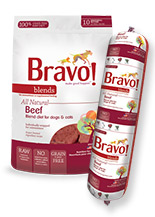Bravo Blends Beef Review
PawDiet has been helping pet owners since 2015. To fund our efforts, articles may include affiliate links; if you buy something through a link, we may earn a commission.
Review of Bravo Blends Beef
According to our most recent data, this product is intended for intermittent or supplemental feeding only.
Review of Ingredients
In our review of Bravo Blends Beef, we'll examine all 8 ingredients and highlight the nutritional contribution of each ingredient.
While the first few ingredients typically dominate the recipe's composition, ingredients in small quantities can still have a meaningful impact on the overall nutritional profile of the recipe.
Beef is a high-quality protein source that provides essential amino acids, vitamins, and minerals to support your dog's muscle development and overall health.
Beef heart is a highly nutritious organ meat, providing your dog with essential amino acids, vitamins, and minerals to support their overall well-being.
Beef bone can provide dogs with essential minerals like calcium and phosphorus, which are crucial for maintaining healthy bones and teeth.
Beef liver is a nutrient-rich organ meat that provides essential vitamins and minerals, such as iron, zinc, and B vitamins, which support your dog's overall health and well-being. It is also a good source of high-quality protein, which helps maintain strong muscles and a healthy coat.
Beef kidney is a nutrient-rich organ meat that provides a concentrated source of essential vitamins and minerals, supporting your dog's immune system, cognitive function, and overall health.
Sweet potato is a highly nutritious and easily digestible source of complex carbohydrates for your dog. It provides essential vitamins, minerals, and dietary fiber, promoting a healthy digestive system and immune function.
Squash is a nutrient-rich vegetable that provides your dog with essential vitamins, minerals, and fiber. It can help support healthy digestion, maintain a strong immune system, and contribute to overall well-being.
Celery is a low-calorie vegetable that provides vitamins and fiber, supporting your dog's digestive health.
Review of Guaranteed Analysis
Crude Protein (min) of 14.00%: The primary contributors to the crude protein content in Bravo Blends Beef are the beef and beef organ meats listed as the first ingredients, including beef heart, beef liver, and beef kidney. These are all high-quality sources of protein that provide the essential amino acids required by pets. Muscle meats like beef and organs such as heart, liver, and kidney are dense in protein, which explains the 14.00% minimum crude protein content in the product.
Crude Fat (min) of 12.50%: The crude fat content is likely to come mainly from the beef, as it naturally contains fat, especially if it includes a variety of cuts. Organ meats also contribute to the fat content, with the beef heart and liver containing natural fats. The 12.50% minimum crude fat indicates that the food is relatively rich in fats, which are crucial for energy, cell function, and the absorption of fat-soluble vitamins.
Crude Fiber (max) of 1.00%: With a maximum of 1.00% crude fiber, this pet food is not very high in fiber. The ingredients contributing to this value are the vegetables included in the formula – sweet potatoes, squash, and celery. These ingredients provide dietary fiber, but since they are listed after the meat ingredients, they are present in smaller quantities, resulting in a low overall fiber content. This is typical for a diet that is meat-centric and mimics a more ancestral diet for carnivorous pets.
Calories of 1800.00 per kg: The caloric content is a measure of the energy provided by the food. The beef and beef organs, with their protein and fat content, are the most calorie-dense ingredients in the product and are the primary contributors to the overall caloric value. The fat in particular is a rich source of calories, which makes sense given the relatively high minimum crude fat guarantee. Sweet potatoes also contribute to the caloric content, but to a lesser extent, given their placement in the ingredient list and the lower fat content compared to the meats.

